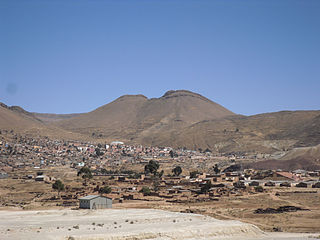
A pinkillu, pinkuyllu or pinqullu is a flute found throughout the Andes, used primarily in Argentina, Bolivia, Chile, Ecuador and Peru. It is usually played with one hand, leaving the other one free to accompany oneself on a drum like the tinya. It is used in a variety of public festivals and other kinds of communal ceremonies.

The aguayo, or also quepina is a rectangular carrying cloth used in traditional communities in the Andes region of Argentina, Bolivia, Chile, Colombia, Ecuador and Peru. Aymara and Quechua people use it to carry small children or all kinds of items in it on their backs. It is similar to a lliklla and sometimes regarded as a synonym.

Llallagua or Llallawa is a town in the Potosí Department in Bolivia. It is the seat of the Llallagua Municipality, the third municipal section of the Rafael Bustillo Province.
Choquepuquio is an ancient Wari site in Peru in the valley of Cusco. These extensive ruins are situated in the Quispicanchi Province, Lucre District, near the village of Huacarpay and the homonymous lake.

Huayruro Punco is a mountain in the Vilcanota mountain range in the Andes of Peru, about 5,550 metres (18,209 ft) high. It is situated in the Cusco Region, Canchis Province, Pitumarca District. Huayruro Punco lies southeast of Callangate, southwest of Chumpe and north of Cóndor Tuco and Comercocha, between the Chillcamayu which originates near Huayruro Punco and the lake named Sibinacocha.
Pumamarka is an archaeological site in Peru. It is located in the Cusco Region, Urubamba Province, Ollantaytambo District, at the confluence of the rivers Patakancha and its affluent Yuraqmayu.
Pumamarka (Aymara and Quechua puma cougar, puma, marka village, "puma village", is an archaeological park in Peru. It is located in the Cusco Region, Cusco Province, San Sebastián District, on the left side of the river Pumamarka. The site was declared a National Cultural Heritage of Peru by the National Institute of Culture.
Tupu Inka is an archaeological site in Peru. It is located in the Puno Region, Yunguyo Province, Unicachi District.
Taqrachullu, Pukara Taqrachullu, T'akrachullu, Pukara T'akrachullu or María Fortaleza is an archaeological site in Peru. It is located in the Cusco Region, Espinar Province, Suykutambo District.

Choquequirao Puquio is an archaeological site in Peru. It is situated in the Cusco Region, Cusco Province, San Sebastián District, north of San Sebastián.

Wilca is an archaeological site in Peru. It is situated in the Amazonas Region, Utcubamba Province, in the east of the Cajaruro District, near the border with the Bongara Province.

Waqrawiri or Waxra Wiri is a mountain in the Wansu mountain range in the Andes of Peru, about 5,425 metres (17,799 ft) high. It is situated in the Arequipa Region, Castilla Province, Orcopampa District. Waqrawiri lies northwest of the lake Machuqucha and south of the river Millumayu.

Chuquiananta is a mountain in the Andes of southern Peru, about 5,300 metres (17,388 ft) high. It is situated in the Moquegua Region, Mariscal Nieto Province, Torata District, and in the Tacna Region, Candarave Province, Camilaca District. Chuquiananta lies south-west of Tutupaca volcano, south-east of Pomani.

Pirca Pirca is an archaeological site in Peru. It is located in the Lima Region, Yauyos Province, Tanta District. Pirca Pirca was declared a National Cultural Heritage of Peru by Resolución Viceministerial No. 011-2013-VMPCIC-MC on February 7, 2013. It lies north of Lake Paucarcocha.

Qurini is a mountain in the Peruvian Andes, about 5,400 metres (17,717 ft) high. It is situated in the Moquegua Region, Mariscal Nieto Province, Carumas District, and in the Puno Region, Puno Province, Acora District. Qurini lies northwest of the mountain Wilaquta and north of the lake Aqhuyach'alla.

Hatun Qurini is a mountain in the Peruvian Andes, about 5,000 metres (16,404 ft) high. It is situated in the Puno Region, Azángaro Province, San José District. Hatun Qurini lies northwest of the mountain Surupana.

Millka is an archaeological site in Peru. It is located in the Ayacucho Region, Víctor Fajardo Province, Sarhua District, northeast of Sarhua. The site of the Chanka period lies on top of a mountain at 3,500 m (11,483 ft).
Sinqa Wayq'u which upstream successively is named Urqulla Wayq'u(Orjollahuayjo), Ancha Pallqa(Anchapallja), Wankarama(Huancarama) and Waraqu(Huarajo) is a river in the Cusco Region of Peru. It is located in the Chumbivilcas Province, Santo Tomás District. It belongs to the watershed of the Apurímac River.

Waraqu is a 5,005-metre-high (16,421 ft) mountain in the Andes of Peru. It is located in the Arequipa Region, Condesuyos Province, Cayarani District, and in the La Unión Province, Puyca District.

Chuqi Warani is a 5,388-metre-high (17,677 ft) mountain in Bolivia. It is located in the Potosí Department, Antonio Quijarro Province, Tomave Municipality. It lies southwest of the Jatun Mundo Quri Warani volcano. In the map of the Bolivian Instituto Geográfico Militar the term Chaupi Mundo is added under Cerro Choquehuarani. This may be an alternate name or a supplement.






